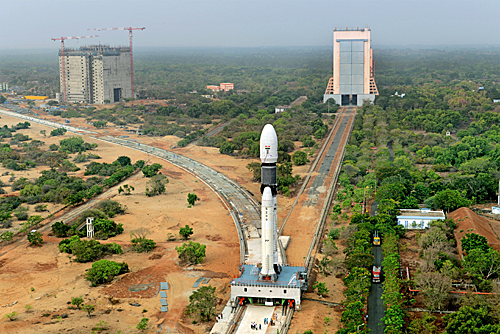
Laxmi Ajai Prasanna has posted an article at the Times of India online infosite that reports that, after the historic launch of the 640 ton, first developmental flight of Geosynchronous Satellite Launch Vehicle (GSLV)-Mark III (D1) on June 5, the team of scientists from ISRO are planning to launch the second developmental flight GSLV-Mark III (D2) by January of 2018 with more payload and higher thrust — ahead of that date, two more GSLV launches and three more PSLV launches are planned that include the latest PSLV-C38 on June 28.

ISRO's GSLV Mark III (D1) being transported to a launch pad.
Photo is courtesy of ISRO.
"With the success of the mammoth 640 ton GSLV-Mk III (D1), its second developmental flight of GSLV-Mark III -D2 is planned for Jan next year," Vikram Sarabhai Space Centre (VSSC) director Dr. K. Sivan stated on his return from Sriharikota last Tuesday. "Now, this launch has placed a powerful 3,136kg high throughput communication satellite GSAT-19 in geosynchronous transfer orbit (GTO) which has a mission life of 10 years. Instead of single transponders, it uses a satellite beam with multiple transponders that will facilitate significant leap in digital communication with its high speed data," he added, with the immediate focus on the launch of PSLV-C38 by June 28.
"The second developmental flight of GSLV-Mk III D2 launch planned in Jan 2018 will have a lift off mass more than 640 ton. Improvisation in vehicle systems is targeted to achieve 500kg more payload than in the D1 launch. The liquid propellant L110 stage will operate at 6 per cent extra thrust throughout the flight duration in the upcoming D2 launch, compared to D1," GSLV MK III Vehicle director J. Jayaprakash stated.
GSLV mission director G. Ayyappan had indicated that the GSLV-Mk III D1 flight placed a 3.2 ton satellite in orbit ,while the same vehicle with modular changes can carry satellites of as much as six tons. He pointed out that it is the success of the "Make in India" space project with its fully indigenous launch with cryogenic technology and in terms of the material and design. Its unique features include dual redundancy, health monitoring, fault detection and isolation system, and the next flight will be even further improved.

